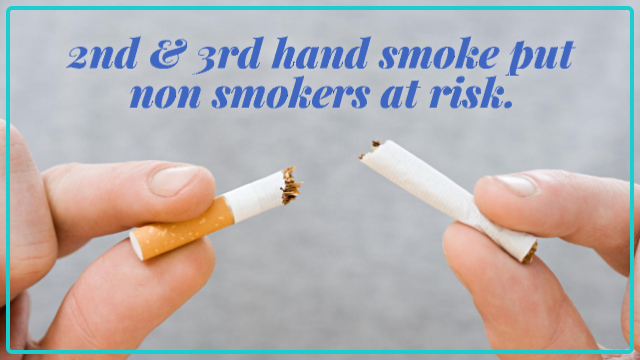
posted
on 8/29/2019
in
Features
Did you know there are approximately 7,000 chemicals in tobacco smoke, including 69 that we know cause cancer? While people generally understand that tobacco use can lead to cancer, heart disease other serious health issues, we also need to consider the risk that second- and third-hand smoke presents to non-smokers. Studies are continuously being conducted to help us learn more, but what we do know is there is no safe level of exposure.
What is the difference between first-, second- and third-hand smoke?
First-hand smoke is inhaled by the tobacco user. In contrast, second-hand smoke is considered both the smoke that comes from the burning end of a cigarette and the smoke exhaled from the smoker. Third-hand smoke, a relatively new term, is the tobacco residue and gases that are left after a cigarette has been smoked. It includes residue that stays on surfaces and builds up on surfaces, furniture, clothing, drapes and carpets.
Why is second-hand smoke a risk?
Second-hand smoke causes approximately 7,330 deaths from lung cancer and 33,950 deaths from heart disease each year, according to the American Lung Association. Even adult non-smokers who live with smokers are at nearly 25 percent greater risk of developing heart disease. Why? Being exposed to second-hand smoke affects an adult’s heart and blood vessels immediately.
Why is third-hand smoke a risk?
When tobacco burns, it releases nicotine in the form of a vapor. This vapor attaches to surfaces like walls, floors, carpeting, drapes, and furniture. Nicotine reacts with nitrous acid in tobacco and forms cancer causing tobacco-specific nitrosamines (TSNAs). The nicotine can last for months on indoor surfaces. This means that these TSNAs are always being created and then inhaled, absorbed, or ingested – even by children and non-smokers.
Are children at an increased risk if exposed to second- and third-hand smoke?
Since their bodies are developing, babies and young children are especially at risk to the toxins in second-hand smoke. In fact, being exposed to second-hand smoke may cause a low birth weight, which increases the chance of developing heart disease and Type 2 diabetes; causes 430 sudden infant death syndrome deaths in the United States annually; and is responsible for up to 300,000 lower respiratory tract infections in infants and children under 18 months of age. Children who are exposed to second-hand smoke are more likely to experience ear infections and have tubes put in their ears, and children who already have asthma have more attacks and more serious attacks.
Children are also more sensitive to being exposed to third-hand smoke because they breathe near, crawl on, play on, touch, and even taste (because they often put their hands in their mouths) surfaces contaminated with tobacco residue.
What can I do to protect myself and my family?
Opening windows in buildings or vehicles and confining smoking to only certain areas of a home doesn’t protect you from the effects of second-hand smoke. While it may get rid of or contain the smell, it cannot get rid of the cancer-causing toxins in the air. The only way to protect your family from second- and third-hand smoke is to create a smoke-free environment in homes and vehicles.
Low Dose CT Lung Screening
There are screening options for those who are at high risk of lung cancer. If you are, or have been a regular smoker, a low dose CT Lung Screening is now an option. This five-minute scan provided at St. Anthony Radiology is for those who:
- Are between the ages of 55 to 77
- Have/had a 30 pack of cigarettes per year history
- Are a current smoker or have quit in the past 15 years
- Are willing to take the next steps to living a healthier lifestyle
Call your medical provider today to see if low dose CT Lung Screening is right for you. Find out how you can quit smoking and put yourself and your loved ones who are exposed to cigarette smoke on the path to a healthier life.
By St. Anthony Radiation Oncologist, Randal Hess, M.D.,
Iowa Heart Center Electrophysiologist, Suzy Feigofsky, M.D.,
and Director of Radiology, Lori Pietig
Filter
- cancer
- cancer center
- cancer services
- lori pietig
- lung screening
- quit smoking
- randal hess
- smoking dangers
- suzanne feigofsky